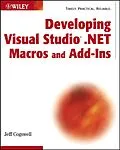* Takes developers step-by-step through the process ofcustomizing Visual Studio to allow easier and faster incorporationof specialized subroutines, UI elements, and other components* Shows how to customize the development environment for macrosand add-ins created in any .NET-hosted language from Visual Studioto Perl, Delphi, COBOL, and Eiffel* Supplies readers with the only print documentation available onall the Macro IDE menu commands* Companion Web site includes all the source code and executablesfor the book
Autorentext
JEFF COGSWELL is a software engineer, author, and consultant. A former teacher, Cogswell has written numerous books, including C++ All-in-One Desk Reference For Dummies® (also from Wiley).
Klappentext
Learn how to supercharge Visual Studio .NET with this in-depth guide to creating customized macros and add-ins
Whether you simply need to automate a repetitive task or make a full-scale improvement to Visual Studio .NET, Jeff Cogswell will quickly teach you how in this comprehensive book. You'll find all the tools necessary to create customized macros and add-ins using the Macros Integrated Development Environment (IDE) of Visual Studio .NET, and the only print documentation available on how to gain complete control over the IDE's menus.
With clear and concise details, Cogswell walks you through macro development, showing you how to automate processes in Visual Studio .NET.
He explains how to use Visual Studio .NET to write add-ins for Microsoft Office, and how to integrate Microsoft Office products such as Word, Excel, and Outlook right into Visual Studio .NET.
Along the way, he also uncovers the ins and outs of deploying your add-ins and presents expert tips and techniques on how to supercharge Visual Studio .NET.
With this book, you'll learn how to:
- Program against the object model and how to develop, save, deploy, and reuse add-ins
- Customize Visual Studio .NET to allow easier and faster incorporation of specialized subroutines, UI elements, and other components
- Develop satellite DLLs that provide for globalization of your software
- Customize the development environment for macros and add-ins created in any .NET-hosted language from Visual Studio to Perl, Delphi, COBOL, and Eiffel
The companion Web site contains all of the source code for the book.
Zusammenfassung
- Takes developers step-by-step through the process of customizing Visual Studio to allow easier and faster incorporation of specialized subroutines, UI elements, and other components
- Shows how to customize the development environment for macros and add-ins created in any .NET-hosted language from Visual Studio to Perl, Delphi, COBOL, and Eiffel
- Supplies readers with the only print documentation available on all the Macro IDE menu commands
- Companion Web site includes all the source code and executables for the book
Inhalt
Acknowledgments.
About the Author.
Introduction.
Part 1: Automating Your Work.
Chapter 1: All about Macros and Add-ins.
What Are Macros and Add-ins?
Why Use Macros and Add-ins?
Automating Your Work with Macros.
Enhancing the IDE with Add-ins.
Online Help for Macros and Add-ins.
Other Ways to Customize Visual Studio .NET.
Manipulating the Windows.
Managing the Toolbars and Commands.
Customizing the Menus.
Moving Forward.
Chapter 2: Just Enough VB.NET.
VB.NET Subroutines and Functions.
VB.NET Variables.
Arrays in VB.NET.
Strings in VB.NET.
VB.NET Control Structures.
Conditional Statements.
Loop Statements.
Exceptions.
Classes in VB.NET.
Other VB.NET Topics.
Moving Forward.
Chapter 3: Introducing the Visual Studio Macro IDE.
The Macro System and the Main IDE.
Macro Development Divisions.
Projects and Modules.
Class Files and Code Files.
Scoping.
Working with the Macros IDE.
The Parts of the Macros IDE.
Managing Projects and Modules.
Creating a New Project.
Loading and Unloading Projects.
Saving Your Project.
Default Macro Location.
Creating a New Module.
Renaming Projects and Modules.
Deleting a Module.
Running a Macro.
Stopping a Macro.
Using the Code Editor in the Macros IDE.
Collapsible Code.
Working with Blocks of Code.
Debugging a Macro.
Working with the Macro Explorer.
Quickly Recording a Temporary Macro.
Selecting the Recording Project.
Recording a Macro.
Editing the Temporary Macro.
Assigning Shortcut Keys to Your Macros.
Moving Forward.
Chapter 4: Macros That Interact with the User.
Referencing Assemblies and Macro Projects.
Referencing External Assemblies.
Referencing Items in Other Macro Projects.
Referencing One of Your Own Assemblies.
Creating Windows and Forms.
Getting Input from a User.
Creating a Form.
Displaying Standard Dialog Boxes.
Working with System Event Handlers.
Categories of Events.
Moving Forward.
Chapter 5: Just Enough .NET Architecture.
Getting to Know Microsoft .NET.
Common Language Runtime.
.NET Class Library.
Packaging Your Software: Assemblies and Manifests.
Looking at an Assembly.
Organizing Multiple Versions of an Assembly.
.NET and OLE/COM.
Globally Unique Identifiers.
Building an Assembly from a COM Component.
Macro and Add-in Models.
Visual Studio Packages.
Visual Studio Project Types.
Accessing Project Types Not Supported by the Macros IDE.
Accessing the Project Object.
Accessing Visual Basic and C# Projects.
Accessing C++ Projects.
Macro IDE Automation Model.
Moving Forward.
Part 2: Enhancing Visual Studio.
Chapter 6: Introducing Add-ins.
About Add-ins.
Startup and Shutdown.
Invoking Your Add-in.
Interacting with the IDE.
Creating Custom Options Pages.
Creating Tool Windows.
Add-ins and the Command System.
Wizards.
Add-ins Are COM Components.
Creating an Add-in.
Using the Wizard.
Building and Running the Add-in.
Managing Add-ins.
Moving Forward.
Chapter 7: Creating Add-ins for the IDE.
Building an Add-in in C++.
Including a GUI with Your Add-in.
Working with Commands.
Using the Forms Library.
Building a Tool Window.
Using the Form Designer with a Tool Window.
Moving Forward.
Chapter 8: Life Cycles, Debugging, and Satellite DLLs.
The Life Cycle of an Add-in.
Debugging an Add-in.
Keeping the Registry Clean.
Debugging the Command-Line Version.
Debugging the Command-Line Add-in.
Setting Up Multiple Debug Configurations.
Creating a Satellite DLL for Resources.
About Culture-Specific Information.
Valid Culture Identifiers.
Adding Culture-Specific Resources in .NET.
Forms and Multiple Languages.
Adding Cultural Assemblies in General.
Making Your Add-ins Multilingual.
Moving Forward.
Chapter 9: Manipulating Solutions and Projects.
Determining the Currently Selected Project.
Manipulating a Project's Items.
Manipulating a Project's Settings.
Accessing and Setting Configuration Properties.
Adding Configurations.
Configuring Projects at the Solution Level.
Configuring Individual Files.
Manipulating…
